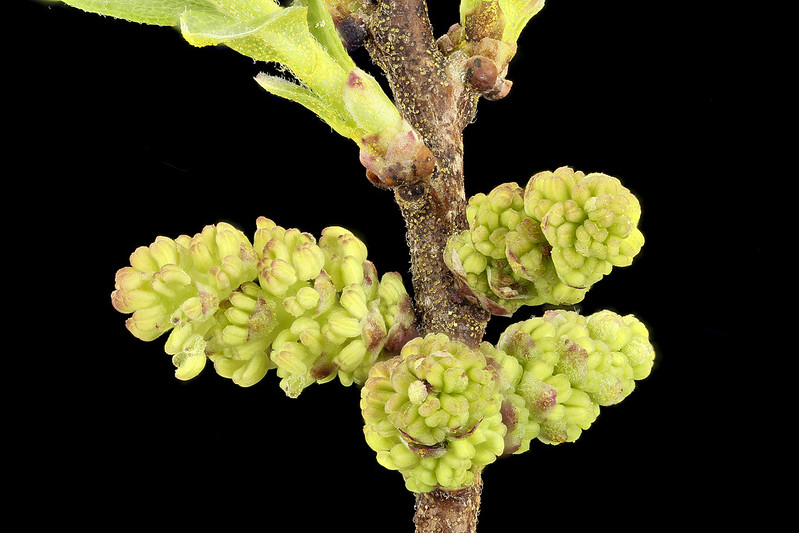Map Snapshot













66 Records
Description
Maryland's three Morella species are similar but with a little effort can be easily separated. First off, Wax Myrtle is by far the most common of the three species. The leaves are narrow - usually less than 1.5 cm wide - and the fruits are usually less than 2.5 mm in diameter at maturity. Northern Bayberry and Southern Bayberry have wider leaves - usually 1.5 to 4 cm wide - with fruits 3 to 7 mm in diameter. Northern Bayberry has resinous glands on the upper and lower surface of the leaves. Southern Bayberry has resinous glands on the lower surface and none (or very few) on the upper surface. Another difference between the two bayberry species is the twigs of Southern Bayberry are hairy and the twigs of Northern Bayberry are smooth.
Where To Find
Morella species are more common on the Coastal Plain than in the Piedmont. Wax Myrtle is the most common species in Maryland. Northern Bayberry is less common but still widespread on the Coastal Plain. Southern Bayberry is very rare and known from only a handful of populations in Maryland.
Relationships
Host plant for a variety of moth species including Little Wife Underwing Moth, Spotted Apatelodes Moth, Io Moth, and Dogwood Borer Moth.
Seasonality Snapshot
Source: Wikipedia
| Myrica pensylvanica | |
|---|---|

| |
| Scientific classification | |
| Kingdom: | Plantae |
| Clade: | Tracheophytes |
| Clade: | Angiosperms |
| Clade: | Eudicots |
| Clade: | Rosids |
| Order: | Fagales |
| Family: | Myricaceae |
| Genus: | Myrica |
| Species: | M. pensylvanica
|
| Binomial name | |
| Myrica pensylvanica Mirbel
| |

| |
| Natural range | |
| Synonyms | |
|
Morella pensylvanica | |
Myrica pensylvanica, the northern bayberry, is a species of Myrica native to eastern North America, from Newfoundland west to Ontario and Ohio, and south to North Carolina. It is also classified as Morella pensylvanica.
Myrica pensylvanica is a deciduous shrub growing to 4.5 m tall. The leaves are 2.5–7 cm long and 1.5-2.7 cm broad, broadest near the leaf apex, serrate, and sticky with a spicy scent when crushed. The flowers are borne in catkins 3–18 mm long, in range of colors from green to red. The fruit is a wrinkled berry 3–5.5 mm diameter, with a pale blue-purple waxy coating; they are an important food for yellow-rumped warblers.
This species has root nodules containing nitrogen-fixing microorganisms, allowing it to grow in relatively poor soils.
Taxonomy
[edit]This plant is one of several Myrica species that are sometimes split into the genus Morella, e.g. in the Integrated Taxonomic Information System. Additionally southern bayberry, M. caroliniensis, and this species are sometimes lumped, disregarding the putative difference that M. caroliniensis is evergreen or tardily deciduous. M. pensylvanica is similar to wax myrtle, M. cerifera. These plants' leaves and scent distinguish them: wax myrtle leaves have scent glands on both sides and are fragrant when crushed, northern bayberry has scent glands mainly on the leaf undersides and is not markedly fragrant. Northern bayberry hybridizes with both southern bayberry and wax myrtle.[1][2]
Uses
[edit]The berries can be used to make bayberry wax candles. American colonists boiled the berries to extract the sweet-smelling wax, which they used to make clean-burning candles.[3][4]

References
[edit]- ^ "Myrica pensylvanica in Floras of North America @ efloras.org". Retrieved 6 June 2014.
- ^ "ITIS Standard Report Page: Morella pensylvanica". Integrated Taxonomic Information System. Retrieved 6 June 2014.
- ^ Mark H. Brand. "Myrica pensylvanica: Northern Bayberry". Archived 2010-08-01 at the Wayback Machine Plant UConn Database of trees, shurbs and vines. Retrieved 2010-10-29.
- ^ "History of Candles." Archived 2012-05-17 at the Wayback Machine National Candle Association (2010). Retrieved 2010-10-29.


